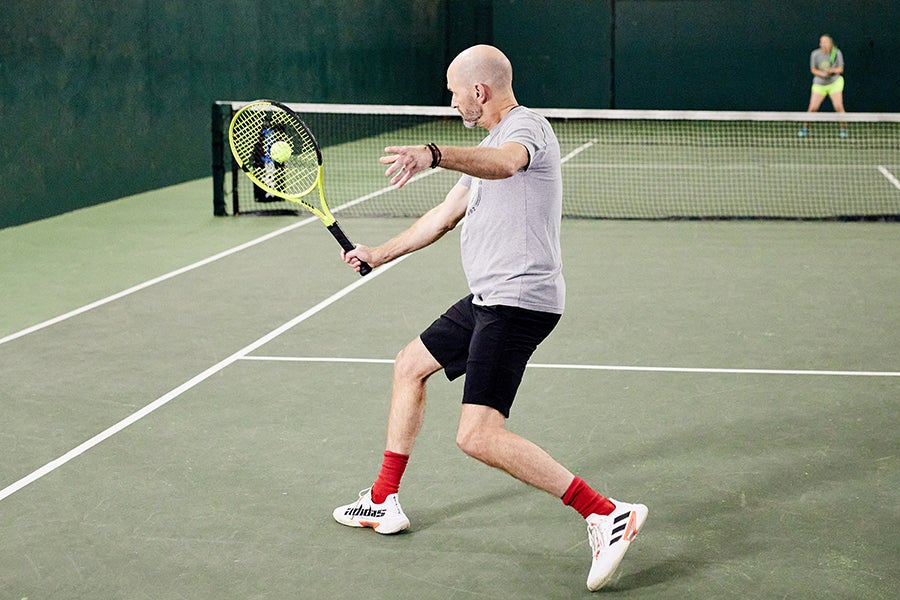Dunlop SX 300 Racquet Review
| Overall | 81 |
|---|---|
| Groundstrokes | 83 |
| Volleys | 82 |
| Serves | 86 |
| Returns | 81 |
| Power | 87 |
| Control | 79 |
| Maneuverability | 87 |
| Stability | 79 |
| Comfort | 79 |
| Touch/Feel | 79 |
| Topspin | 91 |
| Slice | 81 |
Summary
Raise your RPMs with the new Dunlop SX 300. The SX line is one of the more underrated on the market, and this update is one every aggressive spin hitter should test. The mold has been redesigned, with its biggest improvement located in the Spin Boost + Grommets. These grommets are unique to the SX line and feature offset vertical and horizontal grommets in key areas on the main strings to grip the ball for massive spin. In this update, these grommets have been relocated to cover a wider range of contact points, offering spin potential even on off-center hits. The racquet moves swiftly, with a 322 swingweight, allowing players to effortlessly whip spin into their topspin and slice shots. Other racquets that offer similar spin are typically in uncommon string patterns that can create an erratic response, but Dunlop manages to maintain a standard 16x19 pattern, which our playtesters appreciated. No racquet is perfect, though, and our team's main complaint was a lack of depth control on flatter swings. Overall, the Dunlop SX 300 manages to impress, even in a market crowded with great modern spin-focused options. Let's face it, with the new SX 300, someone is going to be spun off the court. The question is — will it be you or your opponent?
Upsides
- Spin
- Power
- Maneuverability
- Easy to use
Downsides
- Stability
- Flat shot control
Ability
All skill levels
Groundstrokes - Score: 83
Our playtesters immediately zeroed in on the Dunlop SX 300's impressive spin potential on groundstrokes. Jason kicked it off by saying, "If you're looking for an easy racquet to get tons of spin and power, look no further. This racquet also offers easy depth thanks to the higher launch angle. I did find that if I wasn't careful to add enough topspin to my shots, they tended to fly on me. It definitely has a bit of a rocket launcher-type feel to it. This is a racquet I felt I couldn't fully swing out on because I was losing too much depth control."
"As I expected, the Dunlop SX 300 had two standout features: spin and maneuverability," Brittany said. "When rallying from the baseline, I was able to rotate my wrist and generate a ton of spin. When I was in match play (singles and doubles), I liked to utilize this spin and hit a variety of shots by playing with different heights and angles. This spin was definitely necessary because the racquet has a high launch angle, specifically when hitting the top half of the stringbed, and I needed to access the spin to get the ball to drop down into the court in front of the baseline. I did love that easy power on approach shots, and I felt like it complemented my aggressive baseline game. Even when I was reaching for the ball from a defensive position, I was able to get my shot to land deep in the court to stay neutral in the point. I would say slice was just OK for me. I felt like I needed more mass behind the ball, and a lot of slices were floating a little. Nonetheless, it is a shot I don't use too often, so it wasn't an issue for me."
Chris noted the SX 300's ability to generate high spin despite just having a standard string pattern. He said, "I liked the shape I got on my topspin shots. The ball left the SX 300 with a high arc so it had plenty of net clearance, then dived inside the baseline before hopping off the court with some nice kick thanks to all of the topspin. The result was a heavy and tough-to-handle ball for my opponents. I felt confident adding lots of pace to my topspin shots because I got so much spin to maintain control. Needless to say, it was a lot of fun. I found the SX 300 to be one of the most spin-friendly options outside of something with a spin-specific string pattern, like a Wilson Spin Effect or Prince ESP racquet. My only issues came when I was hitting flat or with slice. I struggled a little with my targeting on flat shots and tended to miss slice shots into the net. It was frustrating, as I felt like I was hitting a good shot, but I just wasn't getting the desired results. The more I used the racquet, the more I dialed those shots in, but it was definitely the biggest adjustment for me."
Her recent experience with various spin-friendly racquets gave Tiffani some helpful points of comparison. She said, "This SX 300 stood out to me as the most predictable spin racquet for me to hit. I quickly found a groove rallying from the baseline, and I was getting easy depth on my shots. Although I enjoyed rallying with the racquet and found better consistency than some other 'spinny' racquets, I did have a few issues when it came to point play. Because I tend to drive a lot of my shots, I ended up missing more than usual. When I remembered to play with more spin, I had good success. Topspin was easy to generate, but my slice shots were hit and miss, so I liked to stay with my two-handed backhand."

Volleys - Score: 82
Our team agreed that the Dunlop SX 300's strongest attributes at net were its maneuverability and ease of depth. Chris explained, "I gelled with the response of the SX 300 at net. The racquet felt fast in my hands, and that allowed me to easily cut under the ball to add spin. My drop volleys and angles were working well. I was able to get the spin I needed to quickly drop the ball to a short target and get it to spin away from my opponent. There was also ample power to help me punch volleys away. Anything I made contact with above net height could be dispatched with lots of pace thanks to the power I was finding with the SX 300."
"I loved how easy it was to volley with this racquet," Jason added. "I could quickly get it into position for a volley, and the racquet would do the rest. Lots of pop and access to spin meant I was able to put volleys away with ease. It does get pushed around a bit against heavier hitters, but I think it fared well for its weight."
Tiffani and Brittany both noted the racquet's straightforward effectiveness at net. Tiffani said, "This racquet didn't disappoint as I came to net. My default game plan at net is to keep it simple and block back the ball, preferably where my opponent isn't standing. This SX 300 got the job done for me. It was quick to get into position, offered pretty easy depth and felt stable in most instances."
Brittany also lauded the SX 300's stability and maneuverability on volleys. She said, "This racquet felt more stable at net than on groundstrokes. It was really easy to get it into position up at net, and I felt like I could reflex volleys back with ease, even in doubles when I had some quick exchanges. With the feel off the stringbed being on the firmer side, I found myself mostly punching the ball back deep to end points."

Serves - Score: 86
For a modern racquet, being able to successfully generate a variety of serves is a big priority. From whippiness and spin to massive flat power, great racquets do it all. How did the Dunlop SX 300 hold up? According to Jason, the SX 300 performed even better than his current racquet of choice. He said, "Serves were my favorite shot to hit with this racquet. I was getting noticeably more aces and unreturned balls with this SX 300 than with my own racquet. It was super easy to get power on my serve, and I was loving going out wide on the deuce side."
With many spin racquets, control can be lacking on serve; however, Chris thought the SX 300 offered plenty of consistency along with its spin and power. He described, "The SX 300 fit my serving game very well. I liked how much pace I could get on the ball with this racquet. My slice serves had some solid bite to them, and I was able to get the ball to either break away from my opponent or slice into their body to draw weak returns. As usual, I found the best control when utilizing spin, and the amount of spin I could generate with the SX 300 helped keep my serves very consistent. I was able to hit with plenty of clearance over the net and let the spin drop the ball down inside the box."
The SX 300's speedy feel was a hit with Brittany on serves. She said, "The maneuverability and spin came into play on serves as well. It was really easy to generate racquet head speed and maintain it throughout a match. I never felt like I had any arm fatigue. The power was there when I really needed to flatten out a first serve down the T; however, my favorite serve to hit was a slice out wide on the deuce side. I could pull my opponent off the court and then finish the point with a groundstroke to the empty side of the court. There was plenty of access to spin on my second serve, although at times I felt like it was sitting up a little too long, giving my opponent a chance to attack it."
Tiffani, on the other hand, was searching for more oomph. She said, "Considering the easy depth I was getting on my groundstrokes, I was missing a little something on serves. I was able to get better-than-average spin on my slice serves, but I didn't get the weight behind my serves that I wanted. I leaned on using slice for both first and second serves, but I didn't get quite the boost on this shot that I was expecting."

Returns - Score: 81
With returns often requiring more precision and pace redirection, the Dunlop SX 300 was hit or miss with our playtesters. Our team could return second serves aggressively, utilizing the Spin Boost + Grommets to push opponents off court, but returning big first serves was tougher due to a lack of control at times. Tiffani explained, "I didn't struggle quite as much as I would have expected with this SX 300 on returns. There was definitely easy depth, but I was able to add spin to most of my returns to get them to dip into the court. The spin factor even caught my opponents by surprise from time to time. Returning was the only area I can recall finding any torsional instability with this racquet, and it was only against hard incoming serves."
When returning serves with the SX 300, Jason ended up sending the ball long more often than he would have liked. He said, "Much like my groundstrokes, hitting returns with this racquet was slightly hit or miss. I had a tendency to launch shots long simply because of the higher trajectory of the ball off the stringbed."
While he found the racquet a bit inconsistent at times, Chris thought it improved his aggressive returns overall. He said, "I was able to blast some winners with the SX 300. I found it super easy to generate pace. To help with control, I again relied on spin. Both my topspin and slice returns were working well. If I hit flat shots, it was easy to overhit due to the liveliness of the racquet. The only other issue I had was dropping my slice returns too short or into the net."
Brittany concluded the review by weighing the pros and cons of the SX 300's return of serve performance. She said, "There were some things I liked when returning with the SX 300, and a couple of things that I just didn't quite gel with. The first was the spin. I had a lot of fun hitting dipping returns at my opponents' feet when we were playing doubles. The racquet was also easy to swing, so I never felt late when hitting a return. On the other hand, the SX 300 could get pushed around at times, especially when I was returning heavy first serves. I also noticed that if I hit a little lower in the stringbed, it wasn't as forgiving, and there was an immediate drop in power and spin, causing me to miss into the net. This was most noticeable on returns, but it occasionally happened on groundstrokes as well."
Overall - Score: 81
| Technical Specifications | ||
|---|---|---|
| Length | 27 in | 69 cm |
| Head Size | 100 sq in | 645 sq cm |
| Weight | 11.2 oz | 318 gm |
| Balance Point | 13 in 33 cm | 4pts Head Light |
| Construction | 23mm / 26mm / 23mm | |
| Composition | Sonic Core Infinergy/Graphite | |
| String Pattern | 16 Mains / 19 Crosses | |
| Babolat RDC Ratings | ||
|---|---|---|
| Score | Grade | |
| Flex Rating | 68 | Range: 0-100 |
| Swing Weight | 322 | Range: 200-400 |
| Brittany's Scores | |||
|---|---|---|---|
| Power | 8.8 | Serves | 8.4 |
| Control | 7.8 | Groundstrokes | 8 |
| Maneuverability | 8.6 | Returns | 7.7 |
| Stability | 7.7 | Slice | 7.6 |
| Comfort | 7.9 | Topspin | 9.4 |
| Touch/Feel | 7.7 | Volleys | 8 |
| Overall | 7.9 | ||
| Chris' Scores | |||
|---|---|---|---|
| Power | 8.6 | Serves | 8.6 |
| Control | 7.9 | Groundstrokes | 8.3 |
| Maneuverability | 8.5 | Returns | 8.3 |
| Stability | 7.8 | Slice | 8.3 |
| Comfort | 7.8 | Topspin | 8.8 |
| Touch/Feel | 7.8 | Volleys | 8.1 |
| Overall | 8 | ||
| Jason's Scores | |||
|---|---|---|---|
| Power | 9 | Serves | 9.5 |
| Control | 7.8 | Groundstrokes | 8.3 |
| Maneuverability | 9 | Returns | 8.1 |
| Stability | 8.1 | Slice | 8.4 |
| Comfort | 8 | Topspin | 9.2 |
| Touch/Feel | 8 | Volleys | 8.4 |
| Overall | 8.2 | ||
| Tiffani's Scores | |||
|---|---|---|---|
| Power | 8.5 | Serves | 8 |
| Control | 8.2 | Groundstrokes | 8.5 |
| Maneuverability | 8.5 | Returns | 8.3 |
| Stability | 8 | Slice | 8 |
| Comfort | 7.9 | Topspin | 8.8 |
| Touch/Feel | 8 | Volleys | 8.3 |
| Overall | 8.3 | ||
Playtester Profiles
Chris: 4.5 all-court player currently using the Tecnifibre TF40 305. Chris uses a full-western forehand grip, has a fast swing style and hits a one-handed backhand.
Jason: 4.0 baseliner with a semi-western forehand and two-handed backhand. Currently using a customized Prince Twistpower X100.
Tiffani: 4.0 level baseliner with a semi-western grip on the forehand and hits a two-handed backhand. Currently playing with the Prince Textreme Tour 100P (2015).
Brittany: Open level player with a semi-western forehand and a two-handed backhand. She currently plays with the Yonex EZONE 100.










Likes
Tiffani - "This SX 300 offers plenty of spin, but also a predictable response."
Chris - "Great spin, very maneuverable and plenty of power."
Jason - "Tons of spin power. Easy to hit with depth. Fantastic on serve."
Brittany - "I like the easy spin and maneuverability. There is great power potential as well."
Dislikes
Tiffani - "The Dunlop SX 300 is a bit stiffer than I prefer."
Chris - "My slice and flat shots never felt truly natural, although my targeting was improving toward the end of the test."
Jason - "Lack of control at higher swing speeds."
Brittany - "A couple small things, from missing a little stability and mass to wanting a more forgiving sweetspot, as I had issues if I hit slightly low in the stringbed."
Comparing the racquet to others they've tried, our testers said:
Tiffani - "This Dunlop SX 300 is up there with heavy spin racquets. I recently tested the Wilson Clash 100S and Prince Warrior 100 ESP, and this SX 300 ramps up the spin in a similar fashion. The Babolat Pure Aero also would be a comparable racquet."
Chris - "I was so impressed with the amount of spin I could generate with this Dunlop SX 300 that I have to compare it to dedicated spin racquets like the Prince Warrior 100 ESP or the Wilson Clash 100S. Compared to the Clash 100S, the SX 300 feels firmer and crisper, but both offer similar power. Other racquets this one compares to include: Babolat Pure Aero, Head Graphene 360+ Extreme MP and Prince Vortex 300g."
Jason - "Put this Dunlop SX 300 along with the other great spin racquets, like the Babolat Pure Aero, Prince Vortex 300g or Head Extreme MP."
Brittany - "Other racquets with similar characteristics include the Babolat Pure Aero, Head Graphene 360+ Extreme MP, Prince Vortex 300g and Yonex VCORE 100."